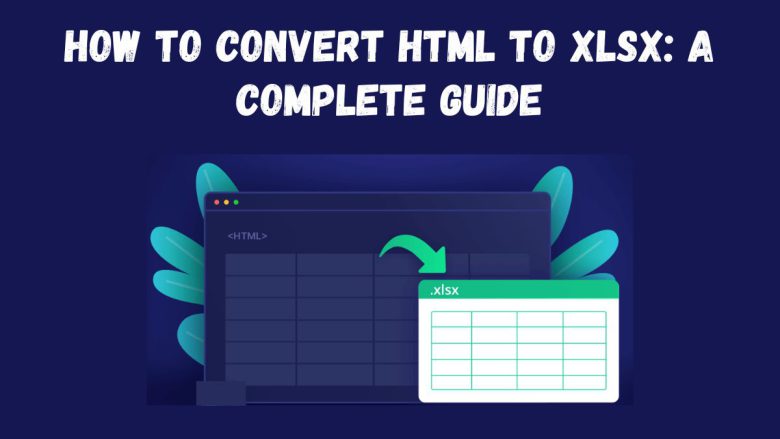
In the digital world, HTML (Hypertext Markup Language) is one of the most common formats for displaying web content. Whether you’re managing data on a website or using it in spreadsheets, there may be times when you need to convert an HTML file to an XLSX format. This conversion is helpful for structuring or analyzing website data in Excel. It makes it easy to calculate, sort, and organize data.
This guide will discuss the benefits of converting HTML to XLSX. It will show you how to use FileProInfo’s free HTML to XLSX converter for the task. It will also provide tips to keep your data safe during the process.
Why Convert HTML to XLSX?
HTML files are the backbone of website content, displaying information through browsers. While HTML is ideal for presenting data visually, it can limit users who want to manipulate or analyze data extensively. Here are some reasons why converting HTML to XLSX can be advantageous:
1. Organized Data Analysis and Calculation
HTML tables display structured data on a webpage. But, they lack Excel’s tools for data manipulation, calculations, and filtering. XLSX is more flexible and functional. It lets you use formulas, pivot tables, and Excel’s powerful analysis tools.
2. Enhanced Formatting and Presentation
Excel has great formatting options. They make data look good and easy to read. Converting HTML to XLSX lets you format your data. You can use options like cell color, font styles, and conditional formatting.
3. Simplified Data Management
Excel spreadsheets make it easier to save, share, and organize data efficiently. Unlike HTML, XLSX files work on many devices and apps. So, they are easier to share and collaborate on with team members.
4. Cross-Platform Compatibility
XLSX works on many devices and platforms. You can open and edit it in different versions of Excel or in apps like Google Sheets. This compatibility makes it ideal for professional use.
Understanding the Differences Between HTML and XLSX
Before starting the conversion, it’s vital to know the key differences between HTML and XLSX formats:
HTML (Hypertext Markup Language)
- Purpose: Primarily used to structure web content.
- Structure: Markup language with tags for elements like tables, images, text, and links.
- Readability: Best viewed in web browsers; not as user-friendly for data analysis.
- Limitations: Limited data manipulation and formatting capabilities.
XLSX (Excel Spreadsheet)
- Purpose: Optimized for data analysis, calculations, and organization.
- Structure: XML-based structure compatible with Excel and other spreadsheet software.
- Readability: User-friendly for data handling and editing.
- Advantages: Robust formatting options, formulas, data validation, and advanced analytics.
How to Convert HTML to XLSX Using FileProInfo
FileProInfo is a simple, reliable tool for converting HTML files to XLSX. Here’s a step-by-step guide on using FileProInfo’s HTML to XLSX converter for a seamless conversion experience.
Step 1: Access the FileProInfo HTML to XLSX Converter
Start by visiting FileProInfo’s HTML to XLSX converter. This online tool is entirely free, and you can use it on any device with internet access, making it convenient and accessible.
Step 2: Upload Your HTML File
Click the “Choose File” button to upload your HTML file. FileProInfo supports a wide range of file sizes, allowing you to convert extensive HTML tables and web data into Excel format with ease.
Step 3: Start the Conversion
Once your file is uploaded, click “Convert” to initiate the process. The converter will process the file and convert it to an XLSX format, ensuring that your data and structure are retained accurately.
Step 4: Download Your XLSX File
After the conversion is complete, a download link will appear. Click this link to download your newly created XLSX file. You can now open it in Excel or any other compatible spreadsheet software.
Best Practices for Maintaining Data Integrity When Converting HTML to XLSX
When converting HTML to XLSX, it’s crucial to maintain the original structure, formatting, and data integrity. Here are some tips to help ensure a successful and accurate conversion:
1. Check Table Structure in HTML File
If your HTML file includes tables, ensure they are correctly formatted before conversion. Well-structured tables in HTML will translate smoothly into rows and columns in Excel, preserving the data layout.
2. Test in Different Browsers Before Conversion
Sometimes, HTML files display differently across browsers. Testing your file in various browsers can help you catch any formatting discrepancies before converting it to XLSX.
3. Review Data for Special Characters
Certain characters, such as symbols and special characters, may not convert properly from HTML to Excel. Review your HTML file for these elements and make adjustments if necessary to prevent data loss or formatting errors.
4. Use FileProInfo for a High-Quality Conversion
FileProInfo’s converter aims to keep the data’s structure and format. It provides a high-quality conversion. It ensures that complex data tables, text elements, and numerical values are accurately transferred from HTML to XLSX.
Advantages of Using FileProInfo for HTML to XLSX Conversion
FileProInfo offers a range of features that make it an excellent choice for converting HTML to XLSX:
1. Free and Accessible Online
FileProInfo’s HTML to XLSX converter is free. There are no hidden fees or subscriptions. It’s a budget-friendly solution for all users.
2. No Software Installation Required
Since FileProInfo is an online tool, you don’t need to install any additional software. You can convert files directly from your browser, which is especially helpful for users with limited device storage.
3. Privacy and Security
FileProInfo prioritizes data security by automatically deleting uploaded files from its servers after conversion. This ensures that your information remains private and secure.
4. Large File Support
The FileProInfo converter supports large files. You can work with big datasets or multiple tables without worry. This is especially valuable for business and professional users handling large HTML tables.
Troubleshooting Common Issues in HTML to XLSX Conversion
Although FileProInfo’s tool is highly efficient, users may occasionally encounter minor issues. Here’s a list of common conversion challenges and solutions:
1. Loss of Table Formatting
If you notice that the table formatting isn’t accurately preserved, check your HTML file to ensure all tags are properly closed. Ensuring clean HTML structure can improve the conversion result.
2. Data Misalignment in Cells
HTML tables with merged cells or irregular structures may convert to misaligned cells in Excel. Adjust your HTML table structure before conversion to match Excel’s grid system for accurate alignment.
3. Special Characters Displaying Incorrectly
HTML files containing special characters may experience display issues in Excel. To avoid this, review your HTML file and replace problematic characters before conversion.
4. Broken Links or Images
Since XLSX primarily focuses on data, images, and hyperlinks from HTML may not transfer correctly. If you need these elements, consider adding them manually after conversion.
Conclusion
Converting an HTML file to XLSX is an excellent way to make web data more accessible for analysis, reporting, and presentation. Use FileProInfo’s free HTML to XLSX converter. It will move your HTML data to Excel. There, you can use its advanced data tools and formatting features.
FileProInfo’s conversion process is simple, fast, and secure. It’s perfect for users who need accurate, reliable conversions. Ready to transform your web data? Try FileProInfo’s HTML to XLSX converter today and unlock the full potential of your data in Excel format.


